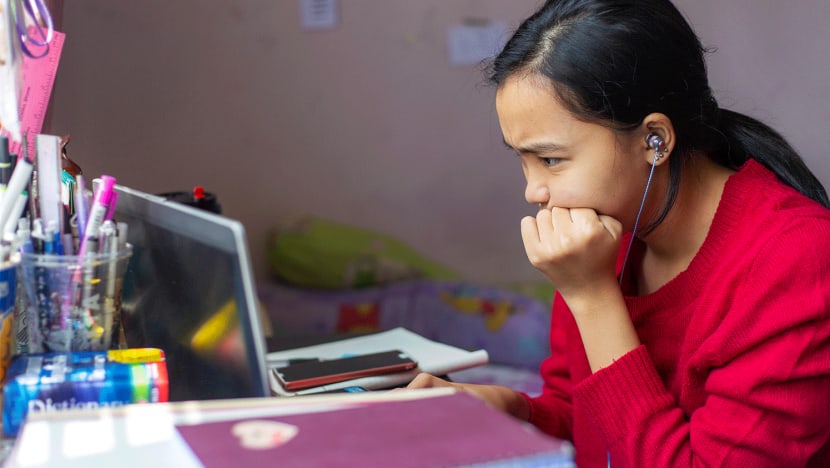Commentary: Identifying signs of dyslexia early can help children avoid traumatic schooling years
October is Dyslexia Awareness Month and debunking myths about the learning disability can be crucial to help children avoid a traumatic experience during their formal education years, says Kuala Lumpur-based health journalist Loh Foon Fong.


This audio is generated by an AI tool.
KUALA LUMPUR: When young children with dyslexia struggle with reading and writing, parents may mistakenly think their little ones have a vision problem.
This was the case for almost all the parents of children with dyslexia she has taught, academic language therapist Choy Su-Ling told me. This can lead them down a path of expensive eye therapy with little bang for their buck.
Children with dyslexia can have perfect vision and still struggle with reading. However, dyslexia and vision problems can co-exist and requires the different expertise of both eye specialists and dyslexia specialists. One of her students, whose parents reduced dyslexia interventions to prioritise behavioral vision therapy, had improvements in her vision but none in her literacy.
Without appropriate support, individuals with dyslexia often suffer from low self-esteem and confidence because they may be wrongly perceived as lazy, slow or lacking in intelligence by teachers, parents and friends. Some may drop out of school and potentially face a challenging future.
So it is crucial to correct such misperceptions and ensure they get the right help.
NOT UNIVERSALLY ACCEPTED DEFINITION
Dyslexia is not fully understood but it is generally considered a neurological disorder. Brain imaging studies showed that people with dyslexia process phonological (related to sounds in a language) information in a different area of the brain than non-dyslexics. They tend to have trouble matching letters and their associated sounds.
It is generally considered as a type of learning disability that affects a child's ability to read, write, comprehend, spell and calculate, despite normal intelligence and adequate stimulation. But consultant paediatrician Dr Amar-Singh HSS pointed out to me that is no universally accepted definition of dyslexia and this poses a problem for determining how common it is and what features will be accepted.
An important reminder, Dr Amar also said, is that other potential causes of learning difficulties should still be ruled out before a child is diagnosed to have dyslexia. This could be some undiagnosed vision or hearing problems, but also intellectual disability or inadequate educational exposure (such as no pre-school education).
In Malaysia, it is estimated that between 4 per cent to 8 per cent of school-going children have dyslexia, and more boys than girls are affected, according to Malaysia’s Ministry of Health.
In Singapore, the proportion of students with dyslexia falls within the international prevalence of 3 per cent to 10 per cent, according to government data from 2016 to 2019. At Primary One, all students are screened and those with weak language and literacy skills receive early intervention through the Learning Support Programme. Those with persistent literacy difficulties are further screened for dyslexia identification.

SUPPORT TO STAY IN MAINSTREAM SCHOOLS
With appropriate intervention and support, many can remain in mainstream education. Helping them cope might require teachers with appropriate training and other reasonable accommodations, such as assistive technology or extra time for examinations.
But since dyslexia is characterised by deficits in speech production, phonology education is crucial, said chartered educational psychologist Tan Cheng Yi. After-school interventional classes can help dyslexic individuals recognise language patterns and are customised for each child, according to language therapist Dr Choy.
There are varied programmes of instructions, several of which are influenced by the Orton-Gillingham approach developed in the 1930s, though studies are mixed as to their effectiveness. More high-quality, rigorous research with larger samples of students is needed to fully understand the effects of Orton-Gillingham interventions.
According to the Mayo Clinic, multi-sensory teaching - involving sight, sound, movement and touch - is considered the gold standard for teaching children with dyslexia to read. Educational psychologist Ms Tan suggested activities such as singing the alphabet to help children associate letters with sounds.
For those who cannot grasp phonics, she suggested using the whole-word approach. The approach teaches children to read by sight, by recognising and remembering the shapes of the entire words, rather than individual letters, and pair the words with images or sounds.
Besides phonological interventions, other things that can help children are family support, family involvement in a dyslexia support group, access to a qualified therapist or a teacher experienced in dyslexia, and the use of online IT tools, Dr Amar told me. Skill-based courses and apprenticeships also offer an alternative path to success.
TAKING DYSLEXIA SERIOUSLY
Experts recommend monitoring children for signs of dyslexia from pre-school so that any red flags can be identified and addressed early before they reach formal schooling, when literacy problems may cripple their self-esteem. It is not a definitive diagnosis at this young age.
However, Malaysia falls behind in such efforts. Public schools conduct simple literacy and numeracy screenings but there is no systematic diagnosis.
It is up to parents to seek diagnosis from developmental paediatricians or registered clinical and education psychologists, Ms Tan said. The waiting time for such specialists in public hospitals in Malaysia can be very long.
Unfortunately, the scarcity of expertise and a lack of awareness can lead to delays in diagnosis. Ms Tan also pointed out that teachers in mainstream schools generally lacked training for teaching dyslexic children.
If we do not take the learning issues of those with dyslexia seriously, they could have a traumatic experience in the education system and miss opportunities to develop their talents as children.
Loh Foon Fong is a senior freelance health journalist based in Malaysia.










.gif?itok=D5A7QHT5)







